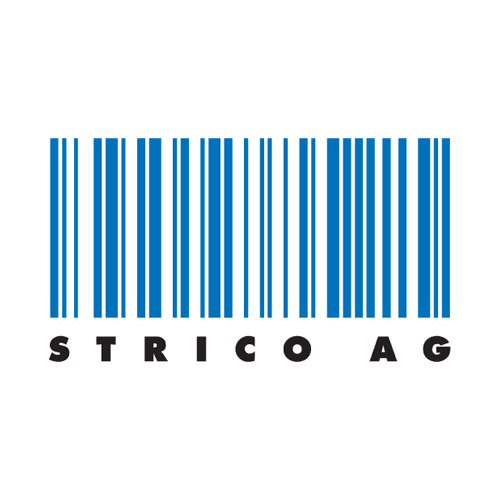KNOWLEDGE
STRICO did not invent the bar code, but its intensive and longstanding preoccupation and subsequent experience with this theme has turned it into an expert in the field of bar code identification.
Our strength is the accumulated know-how in many areas of bar code identification and countless applications thereof.
We would be delighted to assemble the puzzle of bar codes, materials and technologies for you.
Click on the corresponding term for further information on bar codes.
Barcode
What is a bar code?
A bar code is a data carrier, made of an optical pattern. This pattern contains data which can be read by a machine.
The reading equipment (a scanner or a camera system) measures the light which is reflected by the black bars and the white spaces and interprets the content of the bar code. Most bar codes are made of a series of parallel bars and spaces in various widths.
History of the bar code
As early as 1949 the first patent for a bar code was granted in the USA. In Switzerland, Zellweger in Uster started a project in conjunction with the retail chain Migros in the early seventies. However, the semi-circled product code was not successful. Walmart in the USA put pressure on their suppliers and in 1973 the UPC-code, developed by IBM, was introduced. Europe followed in 1976 with the EAN-code.
In the middle of the eighties, a considerable part of the consumer goods in Switzerland was already marked with an EAN-code, while there were still few cash registers with scanners. The break-through of the scanning came when the other processes along the supply chain started to benefit from the advantages of the EAN-system as well.
Besides the consumer goods bar codes EAN and UPC other bar codes were developed, some of them for very specific purposes or branches. Codabar was for many years the standard bar code for blood donations, and Code 39 established itself in libraries and industrial applications, notably in the automotive industry.
As time went on, the demands on automatic data capturing were growing and new symbologies were invented or existing bar codes were further developed. Code 128 can show the full ASCII character set and two-dimensional codes have a high densitiy of information plus an error correction.
The continuous success of the bar code is based on three characteristics: simplicity, reliability and an excellent cost/benefit ratio. A bar code is easy to produce, whether it is printed, laser engraved or woven. The reading is simple too, any off-the-shelf scanner can read the standard bar codes. The high level of security in capturing data by means of a bar code makes this system one of the most reliable methods of all. Countless logistic, medical and production applications rely totally on bar code technology because it is faster and safer than any data entry by hand. This security combined with the simplicity of use account for a favorable cost/benefit ratio. While other technologies might fail in a harsh, industrial environment, bar codes can be used even under extreme conditions.

SYMBOLOGY
There are two main groups of bar codes, the consumer goods bar codes (EAN, UPC and JAN), well known because of their presence in daily life, and industrial bar codes.
In this context, the term industrial is used to describe all bar codes that are not consumer goods bar codes. The most important ones are Code Interleaved 2/5, Code 39 and Code 128.
2D-Codes
2D-codes are bar codes that have been further developed in the sense that they contain information in two axes. In this way, more information can be accommodated in less space. Camera-based scanners are used to read these codes as the picture is treated as a whole when interpreted. The best-known codes in this group are Datamatrix, QR-Code and PDF417.
RFID
RFID stands for Radio Frequency Identification, meaning identification with electromagnetic waves. It is often said that this technology will replace the bar codes. While there is no doubt that there are applications where RFID is advantageous, there are countless applications when bar codes are superior or no other solution is possible.
History of the Bar Code
If you are interested in the background and the history of the bar code, you will find valuable information right here.

NUMBERING SYSTEMS
A series of numbers can be displayed in different ways.
If all the numbers are the same, we speak of constant numbering. If the numbering series is sequential, incremental or descending, the most common system is the decimal system using the numerals from 0 to 9.
In the hexadecimal numbering system the characters A to F are used in combination with the numerals 0 to 9. Using just four digits 65’536 numbers can be created, compared to only 10’000 with the decimal system.
Further numbering systems incorporating the alphabet are called Base 36 (26 characters plus 10 numerals) or Base 32 (22 characters plus 10 numerals). The letters I, L, O and U are omitted to avoid undesirable combinations of letters or misinterpretation of the figures 0 and 1.
If the numbering is chaotic, the series can be produced from a data carrier.

CHECK DIGITS
The use of a check digit increases the safety of the scanning of bar codes.
The check digit is calculated from the data characters according to a defined algorithm. If the scanned check digit does not correspond to the calculated one, the bar code is not accepted. With certain bar code symbologies a check digit is mandatory.
The most common check digit calculations are:
Modulo 10, weighting 3-1-3
Modulo 43
Modulo 103

VERIFICATION
For quality assurance the bar codes are analyzed with specific verification equipment. Every individual element is checked with regard to accuracy, contrast, edge definition plus a number of other criteria, the result is interpreted and a report produced.
The most important specifications are, among others ISO/IEC 15415/15416 and ANSI X3.182.

GLOSSARY
- 2D-Code
- 2D-Scanner
- AI
- AIM
- ANSI
- ASCII-Code
- Aztec code
- Bar
- Bar code
- Base 32
- Base 36
- Binary system
- Bit
- BWR
- Byte
- Check digit
- Codabar
- Codablock
- Code 2/5 interleaved
- Code 2/5 interleaved
- Code 39
- Code 49
- Code 128
- Composite code
- Continuous codes
- Contrast
- Databar
- Datamatrix Code
- Decimal system
- Decodability
- Defects
- DIN
- Discrete codes
- DPI
- DPM
- EAN
- EAN-13
- EAN-128
- EDI
- Element
- Error rate
- First Read Rate FRR
- Fix Scanner
- GCP
- GDTI
- GIAI
- GLN
- GRAI
- GS1
- GS1-128
- GS1 GTIN-8
- GS1 GTIN-12
- GS1 GTIN-13
- GSRN
- GTIN
- Handheld scanner
- Hexadecimal system
- HF
- HRI
- IML
- interleaved Code 2/5
- ISBT-128
- ISO
- ITF
- JAN
- Laser scanner
- Linear codes
- Linear imager
- Magnification
- Maxi code
- mil
- Misreading
- Module
- Module width
- Modulo
- NBW
- Near field
- Non read
- OCR
- Parity
- PDF-417
- Pixel
- Postal codes
- Print contrast
- Print correction factor
- QR code
- Quiet zones
- Ratio
- Reading distance
- Reading pen
- Reading pen
- Redundancy
- Reflection
- Resolution
- RFID
- Space
- SSCC
- Stacked code
- Start / Stop Characters
- Symbol contrast
- UHF
- UPC
- UPC-A
- UPC-E
- Verification
- Weighting
- X-module




